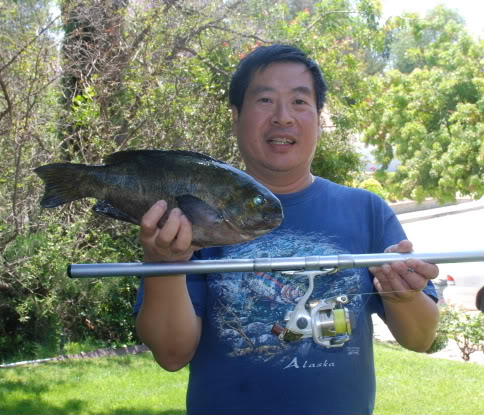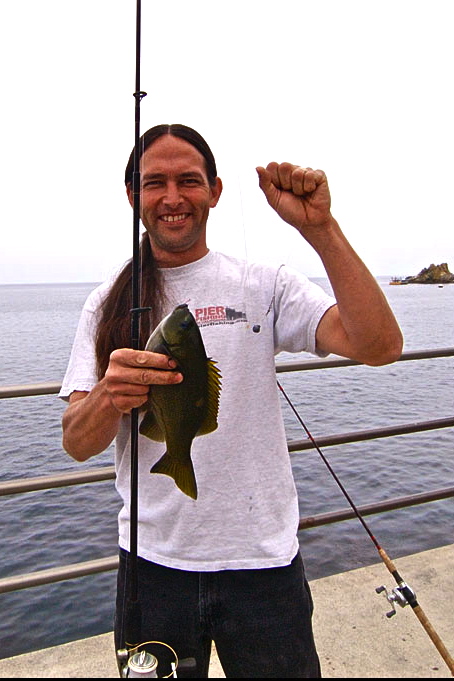Sea Chubs—Family Kyphosidae
 A chubby opaleye taken at the Cabrillo Mole in 2009
A chubby opaleye taken at the Cabrillo Mole in 2009
Species: Girella nigricans (Ayres, 1860); from the French word girelle (a derivative of julis, an old word used to denote a number of small wrasse in Europe), the Latin word nigr (dark) and the Greek word ikanos (becoming, in reference to its pleasing appearance).
Alternate Names: Blue-eye perch, green perch, opaleye perch, bluefish, blue bass, greenfish, Jack Benny, Catalina perch, button-back, button-eye, and button bass. Called chopa verde in Mexico.
 An opaleye from the Oceanside Harbor Pier caught in 2009
An opaleye from the Oceanside Harbor Pier caught in 2009
Identification: Opaleye are perch-shaped but heavier bodied. Their coloring is usually dark olive green and commonly they have two light spots at the base of the dorsal fin. Some fish are pale green or bluish-green while a few almost all white fish have been observed. The eyes are distinctive: large and an opalescent, blue-green color.
Size: To 25.4 inches and 13.46 pounds (a 10-11 year old fish that was speared by David Williams off south Laguna Beach (near Aliso) in 1964). That monster-sized fish, more than double the size of the previous state record, shattered the belief of biologists who had felt that opaleye only reached about six pounds in size. It may be a freakish-record that stands for a long, long time. The California “rod and reel record” fish weighed 6 lb 4 oz and was taken near Los Flores Creek in Malibu in 1956. Most opaleye caught from piers are less than 14 inches in length.
KJ and an opaleye caught at the Cabrillo Mole in 2007
Range: Cabo San Lucas, southern Baja California and the Gulf of California to Otter Rock, Oregon. Uncommon north of Point Conception.
Habitat: Shallow-water, rocky areas and kelp beds.
Minnow Magnet and a nice opaleye taken from the Cabrillo Mole in 2009
Piers: Can be caught from almost any pier in southern California located near rocks, reefs, or kelp. Less common north of Point Conception although taken occasionally at piers in Morro Bay. Uncommon north of Cayucos but a population seems established near the Coast Guard Pier in Monterey. Considered rare north of Monterey. Best bets: Shelter Island Pier, Ocean Beach Pier (inshore), Oceanside Pier, Oceanside Harbor Pier, Dana Harbor Pier, Cabrillo Pier (jetty side), the Green Pleasure Pier and Cabrillo Mole (Avalon), Redondo Sportfishing Pier, and Paradise Cove Pier. Most of the fish caught at SoCal piers are fairly small to mid-size opaleye. The exceptions are the two piers in Avalon that almost always have good-sized fish available for the opaleye-seekers.
 An opaleye from the Green Pleasure Pier in Avalon, 2017
An opaleye from the Green Pleasure Pier in Avalon, 2017
Shoreline: One of the main goals of rocky shore anglers in sourthern California.
Boats: An inshore species rarely taken by boaters unless targeting them at places such as jetties and breakwaters.
Bait and Tackle: Some anglers specialize in opaleye, and many of them swear that moss or frozen peas are the best bait. I’ve actually caught more on ghost shrimp but I must admit that I’ve watched, many a morning, while a group of opaleye “pros” from Los Angeles (I recognize them by now) were filling large coolers with opaleye at the Cabrillo Mole and they almost always use moss as their bait du jour. I think all three baits are excellent for opaleye (although the ghost shrimp are more expensive). Fresh mussels, pile worms, bloodworm, and small rock crabs also make good bait. I also managed to hook a few opaleye using garden snails during an experiment testing different baits at Catalina in 2005. Medium tackle works fine but use a light line, small hooks, and fish the bait under a float of some type since the opaleye will be a mid-depth.
 Opaleye caught at the Green Pleasure Pier by Mahigeer in 2011
Opaleye caught at the Green Pleasure Pier by Mahigeer in 2011
Food Value: A good eating fish that is generally fried.
Comments: Primarily herbivores (vegetarians), opaleye eat a variety of plants including feather boa kelp, giant kelp, sea lettuce and coralline algae. Evidently they also grab organisms attached to seaweed as they’re making their rounds, tasty little items like tube worms and red crabs. Opaleye are a favorite of many anglers; they’re hard to hook but once hooked put up a very good fight for their size.
The crystal-clear waters at Avalon present quite a challenge for the sagacious, line-shy opaleye. Big schools of 2-4 pound fish hang around the Green Pleasure Pier and the Cabrillo Mole but they can be very hard to catch. They seem more cautious of line at the Green Pleasure Pier but if you use a light line, perhaps 2-4 pound fluorocarbon, you might get them. (Actually, to be fair, I catch them every year at the Pleasure Pier and I usually am using 8-10 fluorocarbon). Of course the 1,794 ropes, tangled lines, pilings, floats, shore boats and yellow submarines that surround and hang under the GPP might also get your line.
At the Mole it’s the long fronds and blades of the giant kelp that sway (tidally) in or out near the railing. If the opaleye are allowed to encircle the kelp it’s pretty much over. As soon as they are hooked apply pressure and try to keep them coming toward you while having a person ready with a net. You need to use light line but can also pay the consequences if you’re unwilling to apply enough pressure.
 A large opaleye taken at the Cabrillo Mole in 2014
A large opaleye taken at the Cabrillo Mole in 2014
The opaleye “pros” who come over to Catalina from Los Angeles take the ferry over for one day, fish exclusively at the Mole, fish for one species—opaleye, and are almost always successful (coolers are crammed with fish). You learn from such experts and a few things should be mentioned. The first is that the opaleye are typically at a mid-water depth, five to ten feet under the surface of the water depending upon the depth of the water. They are rarely caught on top and infrequently caught on the bottom (although I’ve caught several fishing on the bottom at night and they are often caught on the bottom by anglers casting out from jetties). Second is that if you want to fish the correct depth a float is desirable and long slip-line floats are the preferred tackle for the opaleye hunters (although bobbers will also work). Third is when you see the float go down, strike and, as mentioned, try to keep the fish out of the kelp. Fourth is that light line (preferably fluorocarbon) and small hooks (size 6 or smaller) are key.
 An opaleye from the Cabrillo Mole in Avalon in 2016
An opaleye from the Cabrillo Mole in Avalon in 2016
Opaleye, especially the older, larger fish can be frustratingly difficult to catch. Chum with peas and a whole school may come up to check out the bait and fish after fish will approach the bait before turning away in seeming disapproval. But, the challenge of out smarting the fish is part of the fun.
 An opaleye caught by Amanda at the Cabrillo Mole in 2013
An opaleye caught by Amanda at the Cabrillo Mole in 2013
 KJ and an opaleye caught at the Green Pleasure Pier in 2014
KJ and an opaleye caught at the Green Pleasure Pier in 2014
 Mahigeer and an opaleye taken at the Green Pleasure Pier in 2010
Mahigeer and an opaleye taken at the Green Pleasure Pier in 2010
 Opaleye taken at the South T-Pier in Morro Bay in 2018
Opaleye taken at the South T-Pier in Morro Bay in 2018
 Large opaleye taken at the Palos Verde rocks by dcc in 2008
Large opaleye taken at the Palos Verde rocks by dcc in 2008
 Large opaleye taken at the Palos Verde rocks by dcc in 2008
Large opaleye taken at the Palos Verde rocks by dcc in 2008



 Four pictures of opaleye taken from the Palos Verde rocks by dcc in 2009
Four pictures of opaleye taken from the Palos Verde rocks by dcc in 2009
KJ and an opaleye from the Green Pleasure Pier in Avalon in 2015
 Jimbojack and an opaleye from the Cabrillo Mole in 2006
Jimbojack and an opaleye from the Cabrillo Mole in 2006
 Brightly colored opaleye from the Shelter Island Pier in San Diego in 2009
Brightly colored opaleye from the Shelter Island Pier in San Diego in 2009
 Less colorful opaleye from the Redondo Sportfishing Pier in 2002
Less colorful opaleye from the Redondo Sportfishing Pier in 2002



















I speared two of these yesterday of the coast in Palos Verdes. One was massive! I cooked them up after soaking in vinegar, garlic and salt. Makes a great eating fish if you put them in tacos. Texture is similar to swordfish.
I speared a 32” monster off the Redondo breakwall in 1987. It was 32” long and had a girth of 22”., well over 15 lbs. Have a picture, how can I pat it?
Thanks!
Send me the pic and I can resize it for a post.
kenjones@pierfishing.com